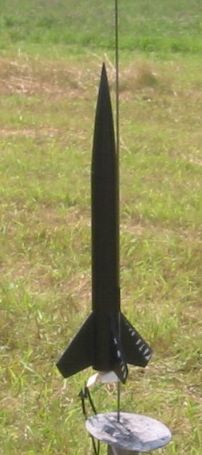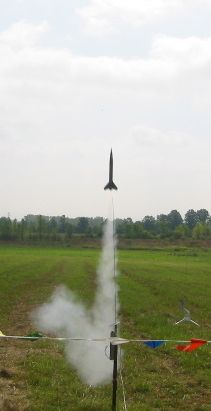Thrustline Aerospace Black Shadow
Thrustline Aerospace - Black Shadow {Kit}
Contributed by Clive Davis
| Construction Rating: | starstarstarstarstar_border |
| Flight Rating: | starstarstarstarstar |
| Overall Rating: | starstarstarstarstar_border |
| Manufacturer: | Thrustline Aerospace |

Brief:
This is a great little sport kit that is easy to build and performs well. I got
the kit as a prize by participating in one of EMRR's Virtual Rocket Contests. I
didn't place in the top five, but I still participated and interestingly I
would have selected the Black Shadow as my prize had I finished first... So the
moral of the story is this: take advantage of the EMRR contests. They are fun
and you get stuff as well!
Construction:
The Black Shadow came with the following parts as well as an instruction kit a
certificate of authenticity (a nice touch):
- balsa nose cone (BT-55 size)
- body tube (BT-55)
- engine tube (18mm)
- launch lug
- black fiber board centering rings
- engine block ring
- fin stock (sheet of balsa)
- screw eye
- mylar parachute kit (9")
- Kevlar® threat
- elastic shock cord
- engine hook
The Black Shadow came in a sealed plastic bag. The instructions are easy to follow and contain photos of various steps. The instructions were 5 pages long and were printed on a laser printer. Quality of parts are very high. I love the balsa nose cone but the balsa sheet I had for fins was slightly warped.
Construction begins with motor mount assembly. No problem here. I like the idea of having the Kevlar® be tied around the motor mount, glued, and then fed up through the upper centering ring. The upper centering ring, when glued into place, also acts as a way of keeping the Kevlar® in place. I also like the engine hook. It is of modest design, but functions well and has great springiness to it without giving up any strength. The lower centering ring was a little tough to fit, but after a little sanding, it went together fine. The black fiber board does leave black residue over the motor mount when it gets in contact with yellow glue, but since this will all be internal, it was not a big deal. The motor mount slid easily into the body tube and I set this aside to dry.
The fin balsa sheet was warped, as I mentioned above. I used my tea kettle and my oven mitts, and simply steamed the wood until it was nice and soft, relatively straight, and moist. I then placed it between two heavy books and took it out the next day. Status: perfect. Based on the quality of the other parts in the kit, I was not concerned about the quality of the balsa. The steam idea worked well and I will be sure to do this to more warped balsa, which I must admit is more common than we would like to admit.
The instructions include a template for fin design, making them easy to cut out, however, I would really appreciate the actual template including a marking of either the root edge or the leading edge or both. I had to actually look at a small photo on the second page for this information. This is not a big deal, but it would have made the construction a little easier. I kept on wondering if I was gluing the right part of the fin on to the body tube. I rounded the fins with sandpaper. Then I ran into my next problem. I used the fin alignment sheet that was included in the instructions. I put the marks on the body tube, then removed the alignment sheet. I kept looking at the body tube, and had an uneasy feeling about the lines. Sure enough, I used my Estes fin alignment tool and realized that the Thrustline alignment sheet was not the same as the Estes fin alignment. I decided to use the Estes fin alignment instead. In the end, the fins look to be perfectly aligned at a 90 degree angle.
The four fins went on easily, then I added a number of glue fillets until I was satisfied that there was a smooth transition from fin to body tube. The next step was adding the screw eye to the nose cone. I used CA but after allowing it to dry, it came loose with a twist. This was weird, because I always use CA on screw eyes in balsa nose cones. The screw was covered with balsa, so I used yellow glue to grip the wood on the screw eye, and then put it in the nose cone. It gripped, and after it dried it was in for good. A piece of cake.
Shock cord construction: I was instructed to create a small loop at the end of the Kevlar® so that it is just inside the body tube then attach the shock cord to this. I like the idea of keeping the Kevlar® inside the body tube, so that it would prevent it from zippering the body tube. Finally, I added the launch lug. The Black Shadow was now constructed and just needed to be finished and flown.
PROs: High quality parts, easy to follow directions
CONs: fin alignment template, warped balsa
Finishing:
I was instructed to seal the fins, and then paint the rocket. I began by
putting Elmer's wood glue over the nose cone to toughen it up and fill in part
of the grain. I used Elmer's Fill 'n' Finish, sanded and primed the rocket
followed by another round of Fill 'n' Finish and priming until the rocket was
ready for painting. The nose cone needed ONE more treatment of Fill 'n' Finish
and primer simply because I wanted to remove all signs of wood grain.
Painting was easy. The kit does not come with decals but the image of the rocket online shows a black rocket with silver/white monokote on the fins. So, I painted my rocket matte black. I did not have any white or silver monokote at home, so when I was with my wife on a trip to Michael's, I stopped in for monokote. Well, these people had never heard of monokote before. I was surprised and disappointed.
Anyway, I did have a collection of vinyl stickers of jungle theme borders, so I used my zebra vinyl stickers to add four bars on the fins. In the end, I thought it looked good. Then, I put a layer of Future Floor Shine over the rocket. I have used Future without any problems before, but on this rocket, Future soaked into the space between the nose cone and the body tube, kind of locking it up. I finally got the nose cone off and then had to add some glue to the inside of the body tube to toughen it up and smooth it out again with sanding. I have learned a lesson now with Future...take the rocket apart and add the acrylic with the rocket in different pieces, if possible.
The parachute kit contained a 9" mylar parachute. It had great quality Kevlar® shroud lines and went together smoothly.
PROs: body tube easy to fill, fins are good quality and primed and painted well
CONs: no decals
Construction Rating: 4 out of 5

Flight:
On a recent club launch, I set up the Black Shadow on an A8-3. It had a great
flight, very stable and straight, and parachute opened right at apogee.
Perfect. I did notice the top of the body tube did get a little wrinkle-dinged,
but this was weird since the parachute opened right at a time when the rocket
was barely moving in the air. Rocket landed fine.
Next flight, I used a B6-4. Another smooth, stable, straight flight. Got a lot of positive comments and praise from other members in my club. The parachute again opened at apogee and it had a great return. I did notice a small hole right in the center of the mylar parachute after the second flight. I always think I have enough wadding when in fact I should probably use another sheet or two.
Recovery:
I prepped with flame-retardant wadding and powdered and folded the 'chute. The
mylar parachute included with the kit is of excellent quality. I would
definitely use Thrustline parachutes again. Recovery was perfect on both
flights except for the minor burn/hole in the mylar 'chute after the second
flight.
PROs: It is easy to prep because it has a wide body tube. Great quality mylar parachute. It also gets decent altitude on an A8, and flies really well on a B6-4. I can't imagine flying it on a C6-5.
CONs: None
Flight Rating: 5 out of 5
Summary:
This is a great kit and it flies VERY well. It is handsome and easy to put
together. I would recommend the following, though:
- Include decals or monokote in kit
- Correct the alignment fin guide so that it is more accurate for fin alignment
- Correct the fin template to indicate which side is root edge and leading edge
Overall Rating: 4 out of 5
Other Reviews
- Thrustline Aerospace Black Shadow By Matthew Bond (June 29, 2009)
[Editor's Note: This review is a clone of the Thrustline Aerospace Black Shadow. Thrustline was out of business for a period of time (when author was cloning the rocket). Thrustline has recently returned to business selling the Black Shadow as a kit.] Brief: In one of my previous incarnations as a BAR I happened upon Thrustline Aerospace, a fairly new (in the summer of 2004) web ...
 |
 |
Flights
 |
 |
 |
 |
G.W. (February 13, 2008)